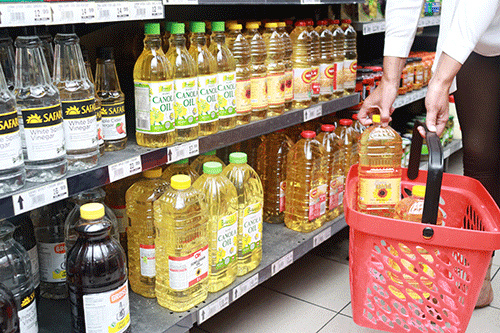The cost of food has sustained an upward trend in recent months, making it difficult for local consumers to put something on the table. Since the first quarter of 2020 when inflation slumped to ultra-low levels amid the pandemic-induced demand slowdown, the rate of increase on food prices has maintained a steady growth, pushing prices of most food items to record highs.
Key food items such as cooking oil and fruit were the main drivers of the unsustainable increases in the price of food.
In a recent report titled ‘First Capital Food Price Monitor for June 2022’, First Capital Namibia noted that from a household perspective, inflation can be seen as reducing the buying power of money spent on consumption.
“Due to inflation, a dollar today is worth more than a dollar sometime in the future. In this context, using the national food price indices, an average Namibian consumer ought
to spend N$177 today to acquire the same basket that costed N$100 in 2012. As food prices rise, a dollar earned will progressively buy less in future, a situation that does not bode well with households, specifically those with constant income levels over time,” the report stated.
The report added the price of meat averaged N$91.55 across the country during the first quarter of 2022 and rose to N$109.18 during the second quarter.
The price for Top Score maize meal, a staple food in Namibia, rose from N$55.69 to N$60.49 and from N$102.41 to N$108.91 for a 5kg and 10kg respectively.
Strikingly, the price of cooking oil per litre increased from an average of N$71.76 to N$100.26 across the country during the review period.
Inflationary impact
During the second quarter of 2022, Namibia recorded an average inflation of more than 5.7% year-on-year, with highest all items inflation being recorded at 6% in June. An analysis of the trends revealed that this is the highest recorded inflation in Namibia in five years. Food and non-alcoholic beverages inflation averaged 6.44% year-on-year in the second quarter of 2022, of which the highest was 6.98%, recorded in June 2022.
With the escalating inflation rates, other sectors are expected to also suffer as consumers have less to spend in the economy.
Furthermore, the First Capital report singled out the price of sunflower oil as a major contributing factor behind rising of food prices: “The rise in the price of cooking oil compounded by continued uncertainty in the commodities market has consumers reeling and is adding to the stress felt by ordinary citizens, fast food entrepreneurs and restaurant owners. The price jump in edible oils globally has started to reflect on the Namibian market, with sunflower oil, and other edible oils seeing massive price hikes,” First Capital stated.
When New Era recently visited an informal trader, Alvina Joseph, at the Soweto Market in Katutura, she said business has been tough as customer volumes are declining and profit margins decrease due to the escalating oil price. “Yoh! The moment I see the price, I just want to run away and leave everything. How can the price jump like that? We rarely make a profit now. If I increase the price, no one buys and I end up making losses. I just have to go with the flow,” narrated Joseph, who has been trading at Soweto Market for more than a decade.
According to the Namibia Statistics Agency (NSA) in its consumer price index bulletin for June 2022, prices for oils and fats increased by 26.2% in June 2022 compared to 16.7% registered during the same period a year earlier. “The increase was reflected mainly in the price levels of cooking fats that escalated (from 11.9% to 26.0%), cooking oil (from 26.6% to 38.8%), and margarine & margarine spreads (from 7.4% to 11.9%),” the NSA explained.
Russian conflict
Russia and Ukraine are the world’s largest exporters of sunflower seed oil. First Capital Namibia added Ukraine contributed 49.6%, 49.8% and 55.4% to total world exports of sunflower from 2019, 2020 and 2021 respectively.
In 2021 alone, Ukraine exported 6.6 million metric tons of sunflower oil to international markets. On the other hand, Russia is the second highest exporter of sunflower oil and contributed 28.9%, 28.5% and 19.5% to total exports globally between 2019 and 2021.
“Evidently, the conflict between Russia and Ukraine removes about 80% of sunflower seed oil from international markets. This is a cause for concern and is expected to put an upward pressure on the price of sunflower oil in the short to medium-term,” explained the bulletin.
Furthermore, First Capital warned prices are expected to moderate towards October/November due to the harvesting of sunflower and canola (crops) in Europe, but this depends heavily on prevailing weather conditions. Equally so, the conflict might further disrupt sunflower and canola planting which might further affect prices in 2023.
According to a World Bank overview, some 1.6 million Namibians currently live in poverty. To overcome rampant poverty in Namibia, the bank advised the implementation of crucial structural policy reforms that it said would be a prerequisite to raise domestic growth potential.
According to the World Bank, these structural reforms are essential measures that ultimately change the fabric of an economy, including the institutional and regulatory framework in which businesses and people operate. The structural reforms, said the World Bank, are designed to ensure the Namibian economy is fit and better able to realise its growth potential in a balanced way.


